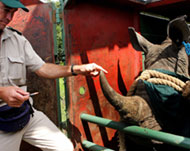How South Africa big game got too big
The big game industry in South Africa, including the sale of elephants and lions, has been so successful supply is outstripping demand, analysts say.

South Africa’s privately owned wildlife and game breeding sector has been a growth industry in recent years, but there are signs it has peaked, with prices declining partly because of the large supply of animals.
Animals are bred for a range of purposes: for conservation, for hunting and for sale to other game reserves. They are captured on both state-owned and private land.
Sales from game auctions in the country last year amounted to 93.5 million rand ($15.30 million) compared with about 101.3 million rand in 2004, according to one estimate.
KZN Wildlife, the conservation body for KwaZulu-Natal province, says revenue raised from its game auctions was about 9.1 million rand last year compared with almost 22 million rand in 2001, but turnover has been up and down.
It remains high enough to support a burgeoning industry dedicated to the live capture and transport of wildlife.
Industry expanding
Petronel Nieuwoudt, who runs a game capture school, said: “It is a growing industry, though nobody knows exactly how many operators there are.
“There are some good operators out there, but unfortunately there are also some fly-by-nighters and that is bad because animals can easily die from stress.”
 |
|
Rhinos are microchipped so they |
KZN Wildlife moves 3,500 to 4,500 head of game each year.
They range from dainty duikers, a small species of antelope, up to elephants.
Recently, the Makhasa Game Reserve, a 1,700-hectare conservation area owned by the local black community, placed its first captured rhino on the market.
The money will be used to raise funds for the nearby villages and the running of the park.
Simon Gumede, the community’s traditional leader, said: “This is going to mean a lot for our community,” as he gripped the animal’s horn while the capture unit went about its work.
Precision crucial
The operation of capturing the animal is carried out with clinical precision: The animal is roped while a hole is drilled in its horns to accommodate a microchip.
Jeff Cooke, the head of the game capture unit for KZN Wildlife, said: “It’s a bar code. It’s unique, so if it ever gets poached, we can trace it.”
The work is exacting, from the timing to the dosages used.
Dragged from the bush into a clearing, the rhino is given a measured adrenaline shot to partly revive it.
This enables the blindfolded animal to stagger to its feet. With a rope around its snout, it is guided by team members into a metal crate, which is winched on to a flatbed truck.
There is no margin for error.
Jeff Gaisford, KZN Wildlife’s communications manager, says: “If the animal gets an incorrect dose, it can come around faster than expected and break loose. Then you’re in trouble.”
Specific treatment
The darting operation involves split-second timing and steely nerves on the part of the pilot and the marksman.
Vere van Heerden, the pilot, explained that he tried “to get within 50 metres of the animal for the darter”.
|
“You handle every species differently and you need to know what you are doing” Petronel Nieuwoudt, |
A darted animal takes four minutes to fall, so Van Heerden tries to make sure the shot is fired near a clearing where it will be easy for vehicles to get close.
“As soon as it is darted, we start a stopwatch,” he said.
A lot can go wrong.
“You handle every species differently and you need to know what you are doing … you can’t use the same drugs for cats that you use for herbivores,” said Nieuwoudt.
“You can use the wrong drug or dose and kill an animal. Or if its position is wrong, it can bloat. Or it can run too far or get stressed when it is being moved,” she said.
Elephants must be doused constantly with water to keep them from overheating and are winched while unconscious into their carrying crates.
Lions are darted at night and individual animals must be separated from the rest of the pride – no easy task.
Costly
The work is expensive.
One KZN source said an operation taking about three hours to find a suitable animal and involving a helicopter could cost
about 20,000 rand.
The community will probably get about 70,000 rand for the rhino and there were plans to catch another for sale.
Game capture vehicles with cranes and crates are expensive and helicopters are needed for rhinos and elephants, pointing to a capital-intensive industry.